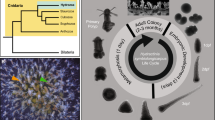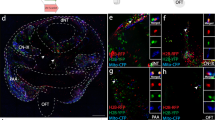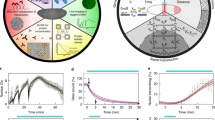Abstract
The introduction of in ovo electroporation a decade ago has helped the chick embryo to become a powerful system to study gene regulation and function during development. Although this is a simple procedure for embryos of 2-d incubation, earlier stages (from laying to early neurulation, 0–1 d) present special challenges. Here we describe a robust and reproducible protocol for electroporation of expression vectors and morpholino oligonucleotides into the epiblast of embryos from soon after laying (stage XI) to stages 6–7 (early neurulation), with precise spatial and temporal control. Within 3 h, about 12 embryos can be electroporated and set up for culture by the New technique; the effects of morpholinos can be assessed immediately after electroporation, and robust overexpression from plasmid DNA is seen 2–3 h after electroporation. These techniques can be used for time-lapse imaging, gain- and loss-of-function experiments and studying gene regulatory elements in living embryos.
This is a preview of subscription content, access via your institution
Access options
Subscribe to this journal
Receive 12 print issues and online access
$259.00 per year
only $21.58 per issue
Buy this article
- Purchase on Springer Link
- Instant access to full article PDF
Prices may be subject to local taxes which are calculated during checkout



Similar content being viewed by others
Change history
04 September 2008
In the version of this article initially published, the recipe for Tyrode's saline on p. 420, under Reagent Setup, contained two errors. "0.5 g NaH2PO4 · H2O" should have read "0.5 g NaH2PO4 · 2H2O". "2 mg MgCl2 · 6H2O" should have read "2 g MgCl2 · 6H2O." These errors have been corrected in the HTML and PDF versions of the article.
References
Stern, C.D. The chick; a great model system becomes even greater. Dev. Cell 8, 9–17 (2005).
Muramatsu, T., Mizutani, Y., Ohmori, Y. & Okumura, J. Comparison of three nonviral transfection methods for foreign gene expression in early chicken embryos in ovo. Biochem. Biophys. Res. Commun. 230, 376–380 (1997).
Nakamura, H., Katahira, T., Sato, T., Watanabe, Y. & Funahashi, J. Gain- and loss-of-function in chick embryos by electroporation. Mech. Dev. 121, 1137–1143 (2004).
Chesnutt, C. & Niswander, L. Plasmid-based short-hairpin RNA interference in the chicken embryo. Genesis 39, 73–78 (2004).
Das, R.M. et al. A robust system for RNA interference in the chicken using a modified microRNA operon. Dev. Biol. 294, 554–563 (2006).
Katahira, T. & Nakamura, H. Gene silencing in chick embryos with a vector-based small interfering RNA system. Dev. Growth Differ. 45, 361–367 (2003).
Hamburger, V. & Hamilton, H.L. A series of normal stages in the development of the chick embryo. J. Morphol. 88, 49–92 (1951).
Sheng, G., dos Reis, M. & Stern, C.D. Churchill, a zinc finger transcriptional activator, regulates the transition between gastrulation and neurulation. Cell 115, 603–613 (2003).
Uchikawa, M., Ishida, Y., Takemoto, T., Kamachi, Y. & Kondoh, H. Functional analysis of chicken Sox2 enhancers highlights an array of diverse regulatory elements that are conserved in mammals. Dev. Cell 4, 509–519 (2003).
Kobayashi, D. et al. Early subdivisions in the neural plate define distinct competence for inductive signals. Development 129, 83–93 (2002).
Uchikawa, M., Takemoto, T., Kamachi, Y. & Kondoh, H. Efficient identification of regulatory sequences in the chicken genome by a powerful combination of embryo electroporation and genome comparison. Mech. Dev. 121, 1145–1158 (2004).
Iimura, T., Yang, X., Weijer, C.J. & Pourquie, O. Dual mode of paraxial mesoderm formation during chick gastrulation. Proc. Natl. Acad. Sci. USA 104, 2744–2749 (2007).
Papanayotou, C. et al. A mechanism regulating the onset of Sox2 expression in the embryonic neural plate. PLoS Biol. 6, e2 (2008).
Stern, C.D. & MacKenzie, D.O. Sodium transport and the control of epiblast polarity in the early chick embryo. J. Embryol. Exp. Morphol. 77, 73–98 (1983).
Chuai, M. et al. Cell movement during chick primitive streak formation. Dev. Biol. 296, 137–149 (2006).
Cui, C., Yang, X., Chuai, M., Glazier, J.A. & Weijer, C.J. Analysis of tissue flow patterns during primitive streak formation in the chick embryo. Dev. Biol. 284, 37–47 (2005).
Chapman, S.C., Collignon, J., Schoenwolf, G.C. & Lumsden, A. Improved method for chick whole-embryo culture using a filter paper carrier. Dev. Dyn 220, 284–289 (2001).
New, D.A.T. A new technique for the cultivation of the chick embryo in vitro. J. Embryol. Exp. Morph. 3, 326–31 (1955).
Voiculescu, O., Bertocchini, F., Wolpert, L., Keller, R.E. & Stern, C.D. The amniote primitive streak is defined by epithelial cell intercalation before gastrulation. Nature 449, 1049–1052 (2007).
Eyal-Giladi, H. & Kochav, S. From cleavage to primitive streak formation: a complementary normal table and a new look at the first stages of the development of the chick. I. General morphology. Dev. Biol. 49, 321–337 (1976).
Takemoto, T., Uchikawa, M., Kamachi, Y. & Kondoh, H. Convergence of Wnt and FGF signals in the genesis of posterior neural plate through activation of the Sox2 enhancer N-1. Development 133, 297–306 (2006).
Stern, C.D. & Bachvarova, R. Early chick embryos in vitro. Int. J. Dev. Biol. 41, 379–387 (1997).
Stern, C.D. & Ireland, G.W. An integrated experimental study of endoderm formation in avian embryos. Anat. Embryol. (Berl). 163, 245–263 (1981).
Pannett, C.A. & Compton, A. The cultivation of tissues in saline embryonic juice. Lancet 206, 381–384 (1924).
Acknowledgements
Our studies are funded by grants from the Medical Research Council, Biotechnology and Biological Sciences Research Council, National Institutes of Health (National Institute of Mental Health) and the European Union (Network of Excellence 'Cells into Organs'). O.V. was a recipient of a Long-term Fellowship from Human Frontier Science Program. We are grateful to A. Barth and Y. Yamamoto for loans of equipment.
Author information
Authors and Affiliations
Corresponding authors
Supplementary information
Supplementary Video 1
Opening the egg and yolk collection (MOV 5149 kb)
Supplementary Video 2
Peeling the vitelline membrane from the yolk. (MOV 7131 kb)
Supplementary Video 3
Trimming and cleaning the membrane. (MOV 3765 kb)
Supplementary Video 4
Explanting a young embryo from the yolk (MOV 2145 kb)
Supplementary Video 5
Freeing the young embryo from the yolk (MOV 10069 kb)
Supplementary Video 6
Freeing an older embryo from the membrane. (MOV 2315 kb)
Supplementary Video 7
The electroporation chamber and electroporation (MOV 3738 kb)
Supplementary Video 8
Finishing the New culture (MOV 7149 kb)
Rights and permissions
About this article
Cite this article
Voiculescu, O., Papanayotou, C. & Stern, C. Spatially and temporally controlled electroporation of early chick embryos. Nat Protoc 3, 419–426 (2008). https://doi.org/10.1038/nprot.2008.10
Published:
Issue Date:
DOI: https://doi.org/10.1038/nprot.2008.10
This article is cited by
-
Regulation of long-range BMP gradients and embryonic polarity by propagation of local calcium-firing activity
Nature Communications (2024)
Comments
By submitting a comment you agree to abide by our Terms and Community Guidelines. If you find something abusive or that does not comply with our terms or guidelines please flag it as inappropriate.



